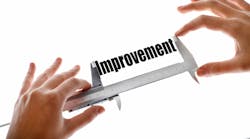Editor’s Note: Larry Fast has penned our Ask the Expert: Lean Leadership column for the past 10 years. This is his last installment as he enjoys a well-deserved retirement, and with his parting words, he examines his greatest career challenge -- the difficult experience of righting the ship at a struggling company and instilling a strong sense of continuous improvement across the enterprise. No doubt many of you have faced similar challenges and joys. On a more personal note, Larry has been a friend to IndustryWeek, and to me, for many years. We and the entire IW manufacturing community have benefited from his insights. -- Jill Jusko, Executive Editor
When I left Belden Wire & Cable Co. in 1997, I moved from a $400 million business and signed on with the fourth-largest wire and cable company in the world -- $4.1 billion General Cable Corp., based in Highland Heights, Kentucky, just across the river from Cincinnati. The General Cable board had recently hired a former GE senior executive as the new CEO. He was a relentless critic with very high expectations, sometimes too high. The entire organization was frustrated at the speed at which he wanted everything done when, in most cases, it simply was not possible. He would raise all kinds of hell without considering that the system infrastructure was inadequate.
Manufacturing Challenges Abound
General Cable had bought four different companies over the years, and there was little commonality with their systems. Building a proper foundation with common systems required major infrastructure changes. There was also a woeful lack of capable leaders in the factories, which were stacked with operators who had come up through the ranks. They were very knowledgeable about running machines, but they lacked the leadership skills and the urgent need to standardize wherever possible.
Thirty-six factories in North America supported five product teams. Those product teams provided product engineering, sales and HR for their teams. Manufacturing leaders managed the factories, process engineering, purchasing and quality. About half of the plants were under achieving because several of my inherited plant managers were performing poorly. We were talent poor with status quo thinking and slow-moving leaders. I was drinking from a fire hose and staring failure in the face.
In Search of Talented Plant Managers
It was important to cut the weak plant managers and hire new ones, and these weren’t changes I could make instantly. It required finding talent, and it took about 18 months to restaff the leadership positions. Several of the new plant leaders had to get up to speed on the technology because they didn’t come with wire and cable backgrounds.
During the first six months I was visiting all the plants to assess staff level talent, supervisors, engineers, etc. Not surprisingly, the good plants had the best staff and the poor plants had mediocre/poor staffs. My HR partner went on a hunt to bring in the plant management talent necessary to begin to right the ship. We both interviewed candidates and chose our new team over a period of nearly a year.
During this time, we also explored plant consolidations. Since the same or similar products were made in multiple plants, our engineering staff helped us identify extra space in some of our best facilities to aid the pace of plant closures. Our best plant, located in Lawrenceburg, Kentucky, was expanded to accommodate telephone and data cables production brought about by the plant closures.
One of the most difficult decisions I had to make was to close all four plants in the cord set and harness business, which were very labor intensive. The people in the U.S. plants did a great job with quality and service, but it wasn’t enough to make a profit. We were non-competitive and had to move these operations to Mexico or exit the business. We moved the plants to Mexico. It took about two years to restore production to proper levels.
The CEO and product business leaders were supportive and mostly helpful. By year three we were harvesting the improvements and aggressively taking cost out with my new roster of plant managers and engineering and supply chain staff.
We Introduce Lean and Six Sigma
Now that the ship was stable, it was time to introduce our continuous improvement initiatives using the tools of lean and Six Sigma. My vice president of quality was the standard bearer for training staff, using the appropriate tools and executing the improvements. Cost reductions began adding up and good processes were passed along to all teams. (Caution: Make sure the sales and marketing folks don’t significantly give back improvements to customers by reducing prices! The finance manager was my best friend in policing the pricing processes.)
The great news is that my corporate VPs of manufacturing and plant managers became strong leaders. This led me to team up with IndustryWeek, and I encouraged plant leaders to compete in the annual IW Best Plants in North America awards competition. This team won numerous IW Best Plants Awards along with a few runners-up. All in all, I left a great team of leaders, and I remain as proud of them now as I was when I retired.
(As an aside, the processes we put in place at General Cable for continuous improvement resulted in me writing my first book in 2011 -- The 12 Principles of Manufacturing Excellence. In 2015 I published a second edition of The 12 Principles of Manufacturing Excellence, A Lean Leader’s Guide to Achieving and Sustaining Excellence. Both are best sellers. The 2015 book is still selling nicely. Pick up a copy.)
Finally, after 10 years of writing IndustryWeek columns, I am retiring. I’m pleased to see others stepping up to continue the sharing of best practices with new insights we can all learn from. Rick Bohan and John Dyer are two of my favorites. It has been a good run. Thanks to all my readers and keep reaching for continuous improvement!
Best regards, Larry E. Fast




